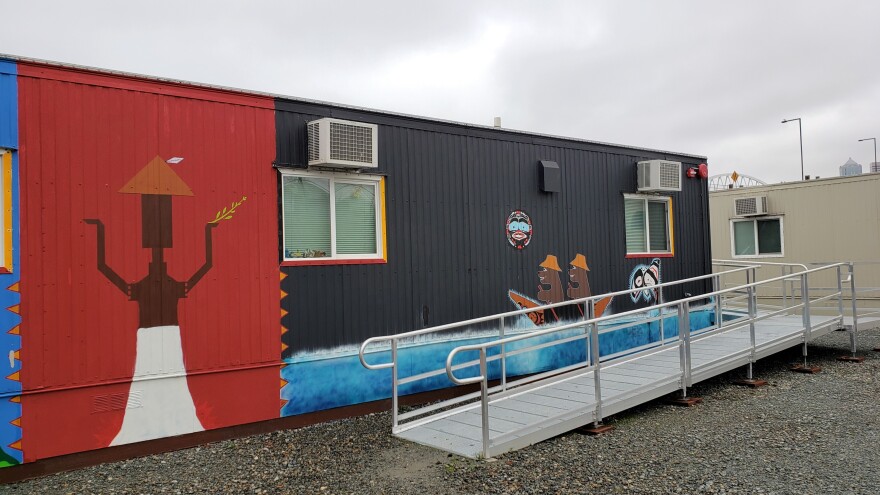A new homeless shelter in Seattle is exclusively serving Native Americans, Alaska Natives and Pacific Islanders. It's one of the first facilities of its kind in the country helping to house the more than 1,000 Native people in the city experiencing homelessness.
Eagle Village sits near Seattle's industrial district south of downtown. It's pressed up against railroad tracks and next to a large bus terminal. Gary Fisher has lived here about a month after bouncing around other shelters in the city for three years.
"A lot of times even sleeping outside in conditions like that might be a better, safer environment than some of the shelters that I've been in," Fisher said in Eagle Village's meeting room.
Fisher says other shelters he's been to have too many people coming and going. "You don't stay by the same person every night," he said," so it's always new people you don't know."
But Eagle Village, he says, is nothing like that. This site is made up of modular trailers divided into small apartments, each with its own private bathroom and kitchenette.
Fisher says the rooms here are comfortable for two people. They've got plenty of closet space, and Fisher has his own bathroom.
Disproportionate homelessness
Thirty people live at Eagle Village full-time, which has capacity for 31 residents. Everybody here — residents, employees, case managers — are all Indigenous peoples, a group that housing advocates say have been largely undeserved by social services. Like in most of the country, Native people in King County, where Seattle is located, make up a disproportionate number of people experiencing homelessness.
"We make up less than one percent of the total population and make up over 10% of our homeless population," says Colleen Echohawk, executive director of Chief Seattle Club, which runs Eagle Village.

Echohawk says because of the history of mistreatment by the U.S. government a lot of Native people don't trust traditional government-run shelters.
"If you had attended boarding school, for instance, or you were in the foster care system or you were one of those folks who have been forcibly sterilized," she says, "the likelihood of you going into a shelter which has those same kind of systems, that same kind of feel, it's unlikely because of how much it will trigger your trauma."
Culturally sensitive
Echohawk describes Eagle Village as "culturally responsible housing," and Chief Seattle Club intentionally chose to use the term village instead of shelter or camp. Eagle Village residents have community meetings, drum circles, and, come springtime, a new medicine garden.
"Before anyone ever got there," Echohawk says, "we had traditional medicine people come through, and they prayed. They offered songs. They smudged and cleansed the entire place."
Residents also come up with dinner ideas and cook for themselves. Eagle Village site manager, Donalda Lyons, says the food is one of the biggest differences here.
"Say they're Lakota and they're like, 'Oh we like this. This is the type of soup we do.' And if we can purchase this stuff here, OK, this is a traditional Lakota soup," Lyons says, "or even from my own res, if there's something that I would like to share with them."
The cost to build Eagle Village was a little over $3 million, paid for in-part by the county and state. Colleen Echohawk says the government is long overdue to fund homeless services for Native people.
"I see this as sort of a way for government officials to fulfill those old obligations that have been forgotten by most part," Echohawk says.
A few years ago she helped launch the Coalition to End Urban Native Homelessness. At the time, it was just based in Seattle. Now Echohawk hopes to partner with other cities to build similar shelters.
"Looking for best practices and looking for what other cities have done, so we'll collaborate," Echohawk says. "It's going to just be this amazing time to to say, 'Oh, what are you doing in Minneapolis? And they're doing great things in Minneapolis. And what are you doing in Seattle and in New York?"
Eagle Village resident Gary Fisher says this is a model not just for Native shelters but for all shelters.
"Homeless shelters are filthy, rotten places for a human being," Fisher says, gesturing around the tidy community room to point out how different Eagle Village is. "Look around you. There's $3 million worth of brand new stuff all around you and I'm part of it. So I'm enjoying it. I'm loving it."
Fisher thinks if Native homelessness can be solved, then all homelessness could be solved as well.
Copyright 2020 KUOW. To see more, visit KUOW. 9(MDA4MjgzNjQ1MDEzMTc5MzUzNzIxNjNmZg004))



